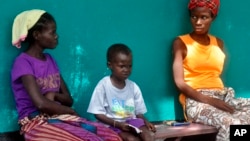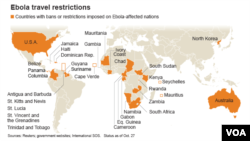After months of near-futile battle with Ebola, a World Health Organization official said a glimmer of hope is beginning to emerge in the worst-affected country, Liberia.
The West African country has recorded 6,535 cases, almost half of the 13,703 total reported in the current outbreak. But Dr. Bruce Aylward, WHO’s assistant director-general, on Wednesday said the infection rate appears to be falling "and there may indeed be a slowing of the epidemic there."
Aylward said Liberia's caseload may be dropping by as much as 25 percent a week. However, he added, "This is no time to let up."
The outbreak's death toll likely has surpassed 5,000 among all countries, he said.
US troops face quarantine
Meanwhile, U.S. Defense Secretary Chuck Hagel has approved strict, quarantine-like monitoring for all U.S. troops returning from the Ebola relief mission in West Africa. The outbreak has hit Liberia, Guinea and Sierra Leone hardest.
President Barack Obama was to meet Wednesday with his public health and national security teams about the government's Ebola response. He also was scheduled to make public remarks from the White House to encourage health care workers battling Ebola in Africa and to explain that U.S. policies are based on their experience and science.
Obama on Tuesday said the United States has ramped up its support for fighting Ebola in West Africa. Since August, he said, the country has increased the number of Ebola treatment units and burial teams and expanded the pipeline of medical personnel and equipment there, as well as launched an aggressive educational campaign.
He praised the "incredible heroism" of American health care workers in West Africa and of the U.S. Agency for International Development’s disaster assistance response team (DART), which deployed there in late summer.
Education efforts continue
WHO's Aylward on Wednesday acknowledged a huge effort to inform the public about how Ebola is transmitted and help them change risky behaviors. Most notably, he said, safe burial practices are being more widely adopted.
He said the Liberian government was mounting a multipronged investigation to determine whether the decline in Ebola cases is real.
"The big, big concern, of course, is that that information would be attributed to the wrong factors ... and then misunderstood in terms of the implications for getting the job finished here," Aylward said.
"This is a very, very dangerous disease," he said. "Any transmission change in any area can rapidly result in a couple of dangerous events and result in many, many more cases."
Aylward cited progress in building up clinical care and treatment capacity. WHO and its partners aim to get 56 Ebola treatment centers, with a capacity of 4,700 beds, operating as soon as possible across Liberia, Sierra Leone and Guinea. Fifteen are in place, he said.
Aylward noted the general mortality rate is 70 percent, though evidence shows people who are quickly isolated and treated in centers have a better chance of survival.
He also said hundreds of doctors and health care staff are needed to minister to patients.











